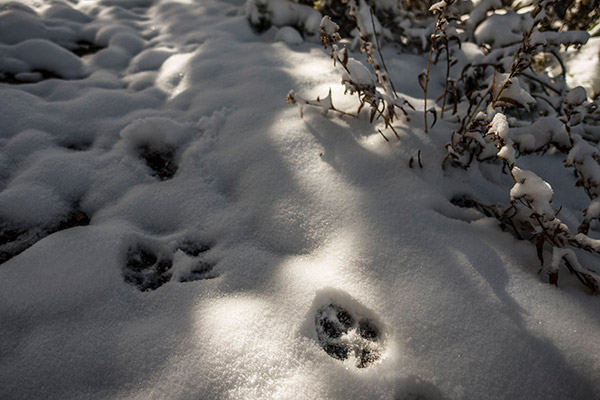Last updated: December 31, 2020
Lesson Plan
Tracks Along the Trail

- Grade Level:
- Upper Elementary: Third Grade through Fifth Grade
- Subject:
- Science
- Lesson Duration:
- 90 Minutes
- Additional Standards:
- NGSS 3-LS4-2. Use evidence to construct an explanation for how the variations in characteristics among individuals of the same species may provide advantages in surviving, finding mates, and reproducing.
Essential Question
What can we learn by looking at animal tracks in the snow?
Objective
Students will identify some common tracks encountered outdoors and will be able to name survival adaptations used by animals during the winter.
Background
Snow is a great writing board for stories about animals. Wildlife viewing is often a matter of luck or being in the right place at the right time. Tracks, whether they're fresh or a few days old, are evidence of wildlife presence; and the tracks reveal much about the private lives and habits of the animals that made them.
Some of the tracks that may be found on a winter outing are shown on the Track Maker Copy Page. Tracks can be difficult to identify at times, depending upon snow type, how old they are and temperature/snow conditions since the tracks were made. Also be alert for other types of wildlife sign including: scat, beds, chewed twig ends, gnawed-on bark, animal lodges and bank dens, hair, feathers, blood, and urine markings. Learn more information about some of W-GIPP's track makers.
Preparation
- Track-Maker copy page
- Narrative copy pages
- Snowshoes (optional)
Procedure
- Before going outdoors or to the Park make copies of the Track Maker copy page (tracks only) for each student. Distribute the Track Maker page and discuss the animal information with your class. Be sure that they realize that the Track Maker Page will be used to identify tracks on the trail and must be brought with them on the field trip.
- Once in the park and on snowshoes, the group will proceed under the direction of the group leader. Using the trailing method, the group will hike into forest or meadow looking for animal sign and tracks.
- As tracks are discovered groups of students will be asked to try to identify them and determine what the animals were doing (feeding, running, sleeping, etc.).
- The students will be asked to determine if the tracks indicate any special winter skill or adaptation for the animal's survival.
- Keep a master list of all tracks for later discussion.
Assessment Materials
Have students review the tracks they found and identified and make a list of adaptations for winter survival. Do tracks tell stories? Who can tell us one story that our tracks showed today? Have students construct their own story-in-tracks on a sheet of paper and share it with the class.
